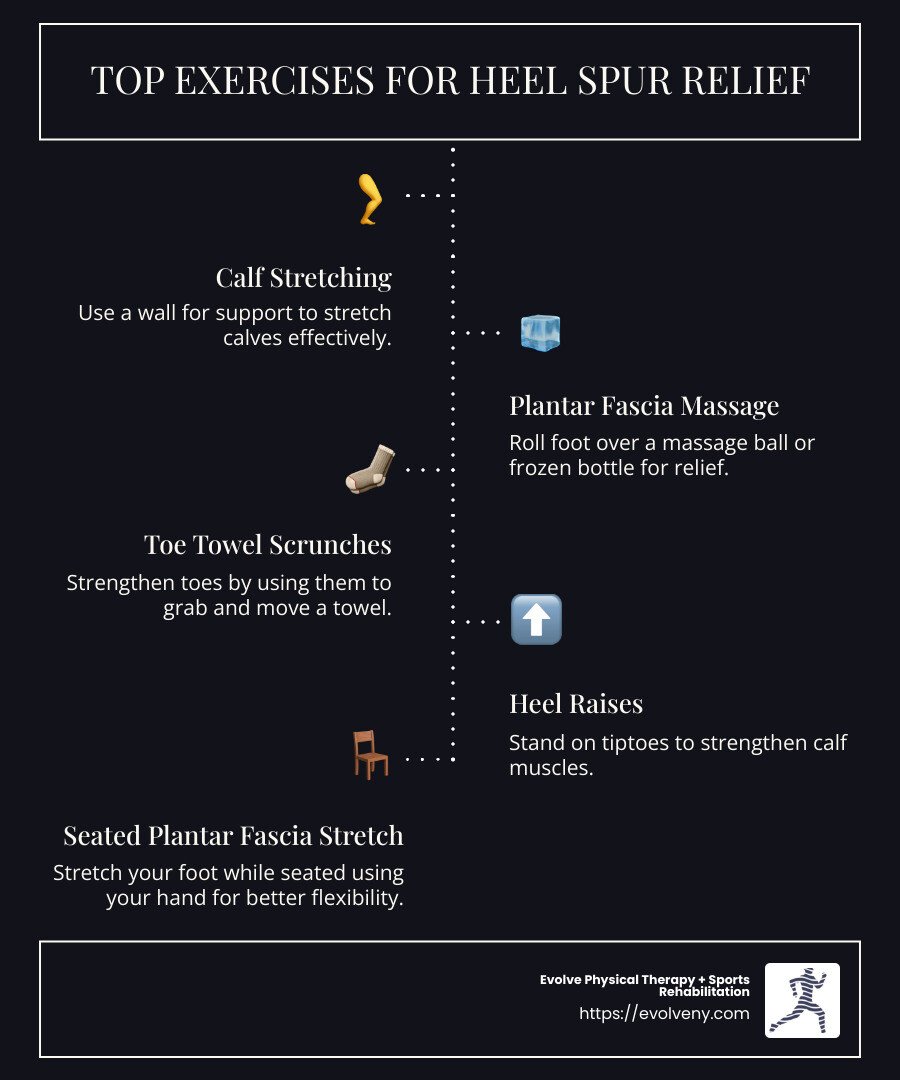Kick Heel Spur Pain to the Curb with These Exercises
Exercises for heel spurs can be a game-changer for anyone struggling with frustrating heel pain. If heel pain is holding you back from daily activities, the right exercises can help manage and reduce discomfort. Here's a quick overview of helpful exercises:
Calf Stretching - Stretch your calves using a wall for support.
Plantar Fascia Massage - Roll your foot over a massage ball or frozen bottle.
Toe Towel Scrunches - Use your toes to grab and move a towel.
Heel Raises - Strengthen your calves by standing on your tiptoes.
Seated Plantar Fascia Stretch - Stretch your foot while seated using your hand.
Heel pain, often caused by plantar fasciitis or heel spurs, is a common complaint that can severely affect your mobility. Heel spurs are bony growths that develop due to long-term strain on your foot's ligaments and muscles. The pain can be particularly intense first thing in the morning or after periods of rest.
I'm Lou Ezrick, a specialist in chronic pain management and founder of Evolve Physical Therapy in Brooklyn, NY. With decades of experience, I've seen how Exercises for heel spurs can effectively alleviate pain and improve quality of life. Let's explore understanding the root causes.
Understanding Heel Spurs
Heel spurs can be a real pain—literally. Understanding what they are and why they happen is the first step to tackling the discomfort they cause.
Heel Anatomy
Your heel is more than just the part of your foot that hits the ground first. It’s a complex structure made primarily of the calcaneus bone, which is the largest bone in your foot. This bone supports your body weight and acts as a lever for your calf muscles, helping you walk, run, and jump.
The Plantar Fascia
The plantar fascia is a thick band of tissue that runs along the bottom of your foot, connecting your heel bone to your toes. Think of it as a shock absorber for your foot. It supports the arch and absorbs the stresses placed on your foot during daily activities.
Causes of Heel Spurs
Heel spurs are bony growths that develop on the bottom of the heel bone. They often occur when the plantar fascia is under constant stress, leading to calcium deposits that form a spur.
Here are some common causes:
Repetitive Stress: High-impact activities like running or dancing can strain the plantar fascia.
Prolonged Standing: Jobs that require long periods on your feet can contribute to the development of heel spurs.
Foot Mechanics: Flat feet or high arches can increase the risk.
Age and Weight: People between 40 and 60 or those who are overweight are more prone to developing heel spurs.
Understanding these factors can help you take preventive measures and choose the right exercises for heel spurs to alleviate pain and prevent further issues.
Next, we’ll explore exercises that can help ease the discomfort and improve your foot health.
Exercises for Heel Spurs
If you're dealing with heel spurs, the right exercises can make a big difference. They can help reduce pain and improve foot flexibility. Let's explore some simple exercises that can help you manage heel spur discomfort.
Calf Stretches
Calf stretches are a great starting point. They help loosen tight calf muscles, which can relieve tension on the plantar fascia. Here's a simple way to do it:
Stand facing a wall.
Place your hands on the wall for support.
Step one foot back, keeping it straight, and bend your front knee.
Lean forward until you feel a stretch in your back calf.
Hold for 20-30 seconds, then switch legs.
Repeat this stretch 2-3 times per leg. As you do this consistently, you'll notice improved flexibility and less strain on your heel.
Plantar Fascia Massage
A gentle massage can work wonders for your foot. It helps relax the muscles and increase blood flow. Try this simple technique:
Frozen Water Bottle Massage: Take a frozen water bottle and roll it under your foot for about 10 minutes. The cold helps reduce inflammation, while the rolling action massages the plantar fascia.
Hand Massage: Sit down and cross one leg over the other. Use your hands to press and release the sole of your foot, avoiding direct pressure on the heel. Do this for about 10 seconds and repeat 10 times.
These massages can be done 2-3 times a day, especially after waking up or sitting for long periods.
Toe Towel Scrunches
Strengthening your foot muscles can support the arch and alleviate heel spur pain. Toe towel scrunches are a simple exercise to try:
Sit on a chair with your feet flat on the ground.
Place a small towel on the floor in front of you.
Use your toes to scrunch the towel towards you.
Repeat 10 times per foot.
This exercise helps build strength in the intrinsic foot muscles, providing better support for your plantar fascia.
By incorporating these exercises for heel spurs into your routine, you can take proactive steps toward reducing pain and improving your foot health. Up next, we'll look at specific exercises that target heel spur pain relief even further.
Top Exercises to Alleviate Heel Spur Pain
Plantar Fascia Massage
A simple yet effective way to ease heel spur pain is through a frozen water bottle massage. Rolling a frozen water bottle under your foot for about 10 minutes not only provides a gentle stretch but also reduces inflammation. The cold helps soothe the area, while the rolling action massages the plantar fascia. This can be done once a day to keep discomfort at bay.
Heel Raise
Strengthening your calf muscles is key to reducing heel pain. The heel raise exercise helps build muscle and improves balance support. Here's how to do it:
Stand with the balls of your feet at the edge of a step.
Hold onto a railing for balance.
Slowly lower your heels below the step's edge to feel a stretch in your calves.
Rise onto your toes, then slowly return to the starting position.
Repeat this 10 times, rest, and perform 2 sets daily. This exercise helps absorb shocks during activities like walking and running, reducing heel strain.
Toe Towel Scrunches
Toe towel scrunches are fantastic for building toe strength and supporting your foot's arch. Follow these steps:
Sit in a chair with your feet flat on the floor.
Place a towel under your feet.
Use your toes to scrunch the towel toward you.
Repeat this 10 times per foot. As you get stronger, try adding a small weight to the towel for an extra challenge. This exercise strengthens the muscles that support your plantar fascia.
Seated Plantar Fascia Stretch
Improving ankle flexibility can help manage heel spur pain. The seated plantar fascia stretch offers a controlled stretch:
Sit on the floor with your legs extended.
Loop a towel or elastic band around the ball of your foot.
Gently pull the towel toward you, stretching your foot and ankle.
Hold for 30 seconds and repeat 3 times. This stretch targets hard-to-reach muscles, providing relief and preventing recurrence of pain.
Wall-Facing Calf Stretch
The wall-facing calf stretch is perfect for those seeking a calf stretch with wall support. Here's how to do it:
Stand facing a wall with your hands placed on it.
Step one foot back, keeping it straight, and bend your front knee.
Lean forward until you feel a stretch in your back calf.
Hold this position for 20-30 seconds and switch legs. Repeat 2-3 times per leg. This stretch helps loosen tight calf muscles, reducing tension on the plantar fascia.
Incorporating these exercises into your routine can significantly alleviate heel spur pain and improve overall foot health. Up next, we'll tackle some frequently asked questions about heel spur exercises to deepen your understanding.
Frequently Asked Questions about Heel Spur Exercises
What is the fastest way to heal a heel spur?
Healing a heel spur quickly involves a combination of stretching, rest, and proper care. Start by incorporating gentle stretching exercises into your daily routine. These exercises, such as the seated plantar fascia stretch, help improve flexibility and reduce tension.
Rest is equally important. Avoid activities that put excessive stress on your heels. If you're on your feet a lot, take breaks to rest and lift your feet to reduce swelling.
Wearing supportive footwear is crucial. Choose shoes with good arch support and cushioning to minimize heel pressure. Inserts or orthotics can also help by redistributing pressure away from the heel.
Is walking OK for heel spur?
Yes, walking is generally OK for heel spurs, but it should be a low-impact exercise. Walking on soft surfaces like grass or using a treadmill with shock absorption can reduce heel stress. Always wear supportive shoes to protect your feet and keep pain at bay.
If walking increases your pain, consider reducing the distance or frequency. Listen to your body and adjust as needed. If pain persists, consult a healthcare professional for guidance.
Can a heel spur be massaged out?
While a heel spur can't be "massaged out," massage can significantly alleviate symptoms. Massaging the plantar fascia and surrounding muscles helps reduce tension and improve blood flow, which can ease pain and promote healing.
Using a massage ball or a frozen water bottle, gently roll it under your foot for several minutes. This not only provides relief but also helps manage symptoms by reducing inflammation and stiffness.
Regular massage combined with stretching and supportive footwear can improve comfort and aid recovery. Always consult a professional if you're unsure about the techniques or if pain worsens.
Next, we'll explore the conclusion of our guide, focusing on how Evolve Physical Therapy + Sports Rehabilitation can support your journey to pain-free living.
Conclusion
At Evolve Physical Therapy + Sports Rehabilitation, we believe in a holistic approach to treating heel spurs. Our team in Brooklyn focuses on evaluating, healing, and strengthening, ensuring that each patient receives comprehensive care custom to their needs.
Our specialized programs are designed to address the root causes of heel pain, not just the symptoms. By incorporating a variety of techniques, including hands-on care and prescribed exercises, we aim to improve mobility, improve physical strength, and promote long-term recovery.
One of our unique offerings is the Rock Steady Boxing program, which has been featured on NBC News. This program is an example of how we integrate innovative methods to support our patients' health and well-being.
If you're struggling with heel spur pain, we encourage you to take the first step towards relief. Our dedicated team is ready to create a personalized treatment plan that fits your lifestyle and goals. Visit our foot physical therapy page to learn more about how we can help you kick heel spur pain to the curb.
With the right support and guidance, you can achieve a pain-free life. Let us be your partner in this journey to better health.


